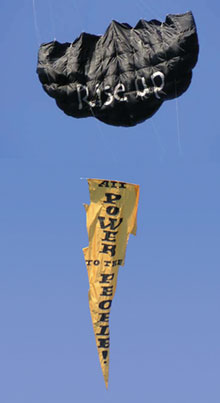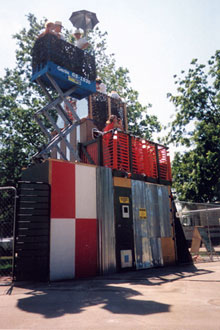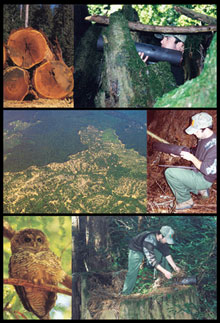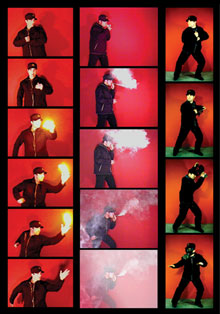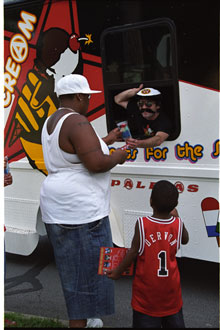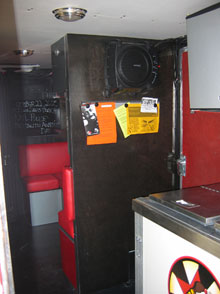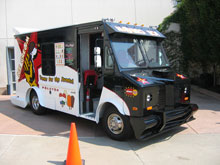 |
   |
| Center for Tactical Magic September 2 - October 15, 2005 Who is the motherfucker rollin’ through the hood? The Coup Out on the street, a curious vehicle is making its approach. Like a mechanized beast from some sci-fi planet, it moves at a lumbering pace, stopping every few hundred feet as if to take a breath. Each time the van stops, a small group of people surround it. And then, a little bit of chaos ensues. Kids ignore their parents’ warnings to stay back. They run right up to the van and peer in. Inside the driver’s cabin, a constellation of tiny lights and gadgets flicker on and off. The driver hops from his seat and asks the kids to pick their favorite treats—one each from two different menus. The first menu offers an array of ice cream flavors, including Da Bomb (red, white and blue) La Bomba (red, green and white) and Black or White Magic (chili chocolate, honey vanilla.) The second menu of stickers, brochures and broadsheets is less familiar, but tantalizing nonetheless. A few skeptical adults try to intervene, but it’s too late. With ice cream and propaganda in their hands, the kids laugh and skip to hip-hop beats blasting from the van. The driver hollers encouragingly to those still keeping their distance. “Step right up folks! We’ve got thirteen flavors to beat the heat, and tasty licks of activist info on everything from anarchism to endangered species!” Rolling through the streets of cities, sidling up to kids in residential neighborhoods, stationed along a curb with it's canopy unfurled, or turning into the gravel lot of a truck stop somewhere along I-70, this is how the Tactical Ice Cream Unit makes its entrance. An amalgam equal parts SWAT van and ice cream truck (with functional and aesthetic flourishes borrowed from the apparatus of armored cars, military transport vehicles, urban hot-rods, and 1950’s-style milk trucks) the Tactical Ice Cream Unit is designed to attract, unsettle, amuse, disarm and engage the public with its strange brew of Good Humor gentility, Willy-Wonka wizardry, and Big Brother bravado. For many, a chance encounter with the TICU will feel like being chocolate-dipped in a sea of sugarcoated doubt. As the TICU makes its approach, the wary among us will have to wonder whether the jaunty interloper promising “Frosty Treats and Food for Thought” is merely a suped-up version of your Friendly Neighborhood Ice Cream Man—or whether the chrome detailing, racing exhaust, and strategically-mounted surveillance cameras on his van mask a far more insidious agenda. Could the US Army be resorting to free ice cream as part of a new, street-savvy marketing and recruitment campaign? Perhaps, but the truck’s driver has a spry manner and devilish look that doesn’t gel with government jobs or law enforcement. Likewise, the driver’s uniform, while official looking, bears an unusual logo with a tell-tale sign for those who look closely: the ‘a’ in Ice Cream is circumscribed. Hats It is not possible to tell from the uniform or hat that a person wears if he or she is part of the legitimate government or a terrorist. It is necessary to look closely at the person's actions to know where he or she stands. Display label from Target America: Opening Eyes to the Damage Drugs Cause, a traveling exhibition produced by the US Drug Enforcement Administration Museum & Visitors Center 1 The Tactical Ice Cream Unit is a project of the Center for Tactical Magic (CTM) based in Oakland, California. CTM is an organization “dedicated to the coalescence of art and social change through ongoing research and development of the pragmatic system known as “Tactical Magic.” 2 Tactical Magic is a program of CTM’s own design, but it is inextricably tied to the more general and widely known category of cultural intervention known as tactical media. Tactical media bridges the worlds of art, activism and science through creative action launched into the public sphere. Grounded in this art-activist framework, the Center for Tactical Magic lays claim to a specific branch of theory and practice based on the occupational strategies of the ninja, the magician and the private investigator—professionals who wear different hats but who nevertheless share an acquired taste for elements of surprise, secrecy and misdirection. Tactical Magic is, in the words of one CTM manifesto, “a fusion force…invoked for the purpose of activating the social imaginary with responsible citizenship through creative action.” Seeking “transformative inversions of power relationships” through “the creative appropriation of seemingly innocuous elements” and “the elaborate integration of all things related,” the purpose of Tactical Magic is to conjure hidden or ignored “links and connections amidst an illusion of order, control, and restriction.” 3 For its own purposes and to assist others in achieving these goals, CTM emphasizes nine key tactics used throughout history by ninjas and noblemen, magicians and magistrates, PI’s and MP’s alike. They are: stealth, surveillance, surprise, sabotage, infiltration, evasion, misdirection, subterfuge, and of course, disguise. Magick is the Art and Science of causing Change to occur in conformity with Will. Aleister Crowley Since organizing in 2000, CTM has performed street-levels interventions, mounted museum exhibitions, and insinuated itself into a variety of other unexpected settings throughout the United States and abroad. Moving fluidly and often stealthily between the worlds of art, activism, and everyday life, CTM’s projects have taken forms as disparate as a community blood drive, an apology pie baked for and personally delivered to the Chinese Vice Consul in San Francisco, free occult services offered on the streets of Chicago, a staged protest in front of the Liberty Bell (with both opposing sides represented by CTM cohorts) and a subversive kite-making and flying workshop on a Southern California beach. Together, these and other CTM projects comprise a polymorphous body of activity that aspires to goals beyond what either art or activism can do on its own. In CTM’s view, the arts (including magical arts, martial arts, and culinary arts) can serve as powerful catalysts for “social, political and cultural counterperception[s]” which in turn summon “the creative and prophetic power of the multitude.” 4 Conjuring this power is of course no small feat, and thus CTM pays ready homage to the magicians, mystics and revolutionaries throughout history who have utilized magic and magical thinking as tools to transform reality. Foremost within this group are Harry Houdini, whose sustained efforts at self-liberation captivated and transformed the popular imagination, and the famed alchemist Cagliostro, whose populist network of mystical lodges may have played a key role in instigating the French Revolution. CTM advocates magical thinking as a useful platform for envisioning alternate realities on the way to making them happen. The Tactical Ice Cream Unit intervenes in our daily lives offering exaggerated and inverted versions of reality, along with much-needed doses of levity and good fun. In and around the TICU, “legitimate” signs of authority and power are fused to their illegitimate, radicalized and deconstructed doppelgangers, so that the result is a shape-shifting, hybrid performance which can be accurately and oppositely interpreted based upon one’s context and bias. This magical manipulation of signs and symbols, based on the Situationist tactic known as détournement, is a consistent and defining element of CTM’s practice. 5 In 2000, for example, CTM developed the Cricket Activated Defense System as a proposed method of resistance to illegal logging in the redwood forests of California. According to CTM, the CAD system is designed to empower a quorum of crickets emitting a distress signal in the forest to set off a shower of missiles aimed at loggers. Delivered as a lecture to university audiences and art gallery-goers, the Cricket Activated Defense System sets the stage for a contentious ethical debate about ecology, industry and activism. In some venues, this debate was stirred, but in others, audience members sat quietly and attentively as members of CTM described the destructive capability of the Defense System in startling detail. Two more recent projects help contextualize the Tactical Ice Cream Unit within CTM’s larger program. In 2002, CTM created a public architectural installation called the Smoky Hill River Outpost. A clubhouse, pyramid, pentagon and panopticon in one, the SHRO, like the TICU, possessed an inviting, if not slightly ominous, exterior face. Sited at an outdoor festival of the arts, kids and adults lined up to await their turn to enter the Outpost. Once inside, visitors encountered a magical environment complete with a sliding bookcase, ouija board, false doors, telescopes, and crystal ball. Less obvious, but available for discovery, were examples of modern “information acquisition” technologies including tinted security domes, police and cell phone scanners, and a surveillance camera mounted in the stuffed snout of a hairy boar. 6 Deliberately conflating the magical and the technological, the SHRO offered a hands-on laboratory where various mechanisms of information gathering and social control could be tested, manipulated and challenged. Also in 2002, CTM initiated the ongoing process of designing, creating, and making available for sale the Ultimate Jacket. Observing that private investigators, magicians and ninjas all use secret pockets in their day-to-day activities, and inspired by the notion that “power deplores a void,” CTM set about to create the ultimate utilitarian garment with “no less than fifty secret pockets.” 7 According to CTM’s early promotional materials, the Jacket is “designed to hold a vast array of useful items for everyday interdiction” and is thus the “perfect complement for any tactical operation, emergency situation, or social occasion.” 8 Like the Ultimate Jacket, the TICU and its scout vehicle, the Tactical Ice Cream Cart, are designed to accommodate a wide range of needs and possible scenarios. Playing the role of the friendly neighborhood ice cream truck is but one possible use for a vehicle loaded with surveillance cameras, satellite internet access, live media transmission technologies, and a global positioning system. At the core of the TICU’s operations is a mobile distribution center for ice cream and information, designed to make mobile communications technologies available to grassroots activists and the “sweet-toothed citizenry” 9 at large. The TICU will also serve communities by monitoring police activities, supporting activists at protests, and distributing information from local progressive groups. Given this range of possible uses, it should be no surprise to find that the TICU (or Tea Coup, or Tactical Intensive Care Unit, or Tactical I See U) like the Outpost and the Jacket, literally holds its cards tightly, concealing much of what it contains. Visitors to the exhibition at Grand Arts are invited to explore the TICU’s interior, and perhaps uncover some of its hidden contents. But those who encounter the TICU in the streets will have to settle for the Feds’ advice, and pay close attention to the TICU’s actions if they want to know “where it stands.” 10 Stacy Switzer 1 For more information on this exhibition, see <http://www.targetamerica.org> 2 Center for Tactical Magic website, <www.tacticalmagic.org> 3 Ibid. 4 Ibid. 5 For a useful discussion of contemporary artists’ appropriation of Situationist strategies, see Nato Thompson and Gregory Sholette, Eds. The Interventionists: Users’ Manual for the Creative Disruption of Everyday Life (North Adams, MA: MASS MoCA Publications, 2004). 6 CTM website, <www.tacticalmagic.org> 7 Author’s interview with the Center for Tactical Magic, July, 2005; CTM Ultimate Jacket promotional materials, 2002. 8 Ultimate Jacket promotional materials, 2002. 9 CTM proposal to Grand Arts, 2003. 10 Display label from Target America: Opening Eyes to the Damage Drugs Cause, exhibition produced by the Drug Enforcement Administration Museum & Visitors Center, 2004.
|
